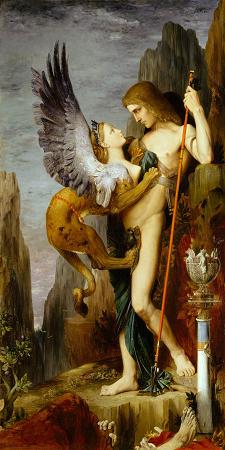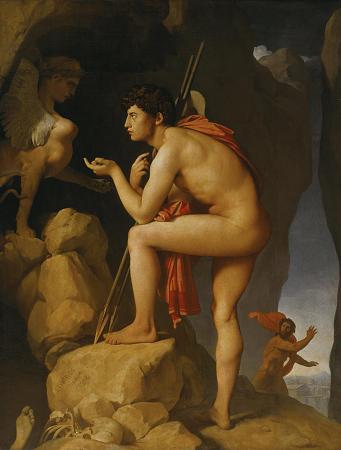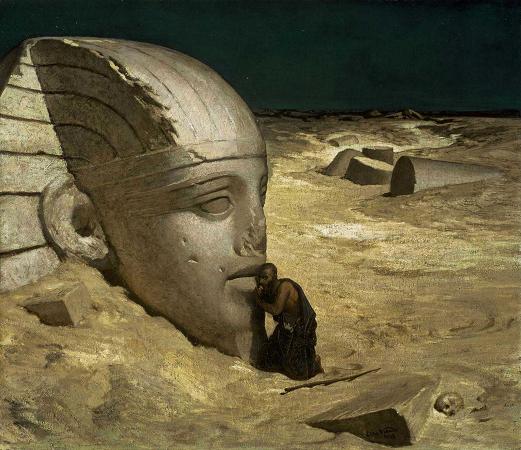Sphinx. A sphinx is a mythical creature with the head of a human and the body of a lion. In Greek tradition, the sphinx has the head of a human, the haunches of a lion, and sometimes the wings of a bird. It is mythicised as treacherous and merciless. Those who cannot answer its riddle suffer a fate typical in such mythological stories, as they are killed and eaten by this ravenous monster. This deadly version of a sphinx appears in the myth and drama of Oedipus. Unlike the Greek sphinx, which was a woman, the Egyptian sphinx is typically shown as a man. In addition, the Egyptian sphinx was viewed as benevolent, but having a ferocious strength similar to the malevolent Greek version. Both were thought of as guardians, and often flank the entrances to temples. In European decorative art, the sphinx enjoyed a major revival during the Renaissance. Later, the sphinx image, initially very similar to the original Ancient Egyptian concept, was exported into many other cultures, albeit there often interpreted quite differently due to translations of descriptions of the originals and through evolution of the concept in relation to other cultural traditions. Sphinxes depictions are generally associated with architectural structures such as royal tombs or religious temples. The oldest known sphinx was found 195 kilometres to the east at Kortik Tepe, Turkey, and was dated to 9,500 B.C. The largest and most famous sphinx is the Great Sphinx of Giza, situated on the Giza Plateau adjacent to the Great Pyramids of Giza on the west bank of the Nile River and facing east. The sphinx is located southeast of the pyramids. While the date of its construction is not known for certain, general consensus among egyptologists is that the head of the Great Sphinx bears the likeness of the pharaoh Khafra, while a fringe minority of late 20th century geologists have claimed evidence of water erosion in and around the Sphinx enclosure which would prove that the Sphinx predates Khafra, a claim that is sometimes referred to as the Sphinx water erosion hypothesis, but which has little support among egyptologists. What names their builders gave to these statues is not known. At the Great Sphinx site, a 1400 B.C. inscription on a stele belonging to the 18th dynasty pharaoh Thutmose IV lists the names of three aspects of the local sun deity of that period, Khepera-Ra-Atum. Many pharaohs had their heads carved atop the guardian statues for their tombs to show their close relationship with the powerful solar deity Sekhmet, a lioness. Besides the Great Sphinx, other famous Egyptian sphinxes include one bearing the head of the pharaoh Hatshepsut, with her likeness carved in granite, which is now in the Metropolitan Museum of Art in New York, and the alabaster sphinx of Memphis, Memphis, Egypt, currently located within the open-air museum at that site. The theme was expanded to form great avenues of guardian sphinxes lining the approaches to tombs and temples as well as serving as details atop the posts of flights of stairs to very grand complexes. Nine hundred sphinxes with ram heads, representing Amon, were built in Thebes, where his cult was strongest. The Great Sphinx has become an emblem of Egypt, frequently appearing on its stamps, coins, and official documents. In the Bronze Age, the Hellenes had trade and cultural contacts with Egypt. Before the time that Alexander the Great occupied Egypt, the Greek name, sphinx, was already applied to these statues. The historians and geographers of Greece wrote extensively about Egyptian culture. Herodotus called the ram-headed sphinxes Criosphinxes and called the hawk-headed ones Hieracosphinxes. In Greek mythology, a sphinx is represented as a monster with a head of a woman, the body of a lioness, the wings of an eagle, and a serpent-headed tail. The word sphinx comes from the Greek, apparently from the verb, meaning to squeeze, to tighten up. This name may be derived from the fact that, in a pride of lions, the hunters are the lionesses, and kill their prey by strangulation, biting the throat of prey and holding them down until they die. However, the historian Susan Wise Bauer suggests that the word sphinx was instead a Greek corruption of the Egyptian name shesepankh, which meant living image, and referred rather to the statue of the sphinx, which was carved out of living rock, than to the beast itself. There was a single sphinx in Greek mythology, a unique demon of destruction and bad luck. According to Hesiod, she was a daughter of Orthrus and either Echidna or the Chimera, or perhaps even Ceto; according to others, she was a daughter of Echidna and Typhon.
more...









